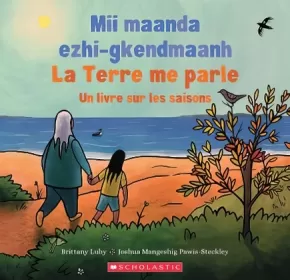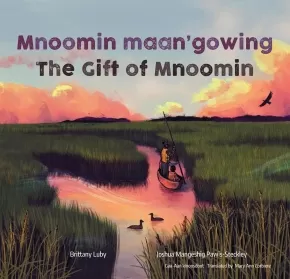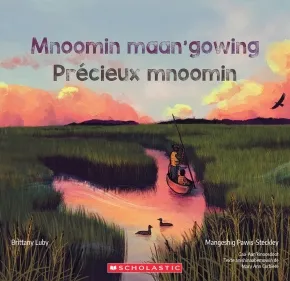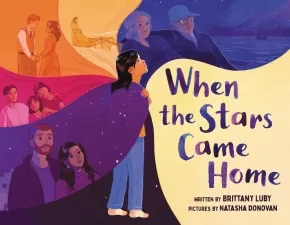
Brittany Luby
Brittany Luby, of Anishinaabe descent, was raised on Treaty #3 Lands in what is currently known as northwestern Ontario. She is an associate professor of history at the University of Guelph who seeks to stimulate public discussion of Indigenous issues through her work. Her picture books include the award-winning Mii maanda ezhi-gkendmaanh / This Is How I Know, illustrated by Mangeshig Pawis-Steckley. Brittany now lives on territories cared for under the Dish with One Spoon Covenant.
Books (1)
Dammed: The Politics of Loss and Survival in Anishinaabe Territory
$27.95
Format: Paperback
Text Content Territories:
Indigenous Canadian; First Nations; Anishinaabeg;
Grade Levels: University/College;
ISBN / Barcode: 9780887558740
Synopsis:
Synopsis:
Dammed: The Politics of Loss and Survival in Anishinaabe Territory explores Canada’s hydroelectric boom in the Lake of the Woods area. It complicates narratives of increasing affluence in postwar Canada, revealing that the inverse was true for Indigenous communities along the Winnipeg River.
Dammed makes clear that hydroelectric generating stations were designed to serve settler populations. Governments and developers excluded the Anishinabeg from planning and operations and failed to consider how power production might influence the health and economy of their communities. By so doing, Canada and Ontario thwarted a future that aligned with the terms of treaty, a future in which both settlers and the Anishinabeg might thrive in shared territories.
The same hydroelectric development that powered settler communities flooded manomin fields, washed away roads, and compromised fish populations. Anishinaabe families responded creatively to manage the government-sanctioned environmental change and survive the resulting economic loss. Luby reveals these responses to dam development, inviting readers to consider how resistance might be expressed by individuals and families, and across gendered and generational lines.
Luby weaves text, testimony, and experience together, grounding this historical work in the territory of her paternal ancestors, lands she calls home. With evidence drawn from archival material, oral history, and environmental observation, Dammed invites readers to confront Canadian colonialism in the twentieth century.
Additional Information
256 pages | 6.00" x 9.00" | 2 maps, index, bibliography
Kids Books (6)
Encounter
$24.99
Artists:
Format: Hardcover
Text Content Territories:
Indigenous Canadian;
ISBN / Barcode: 9780735265813
Synopsis:
Synopsis:
Two people navigate their differences with curiosity and openness in this stunning picture book that imagines the first meeting between an Indigenous fisher and a European sailor.
Based on an actual journal entry by French explorer Jacques Cartier from his first expedition to North America in July 1534, this story imagines the first encounter between a European sailor and a Stadaconan fisher. As the two navigate their differences (language, dress, food) with curiosity, the natural world around them notes their similarities. The seagull observes their like shadows, the mosquito notes their equally appealing blood, the mouse enjoys the crumbs both people leave behind.
This story explores how encounters can create community and celebrates varying perspectives and the natural world. It is at once specific and universal. It's a story based on a primary document and historical research, but it is in equal measure beautifully imagined. It makes room for us to recognize our differences while celebrating our shared humanity.
Debut author Brittany Luby's background in social justice and history brings a breathtaking depth of insight and understanding to this story and Michaela Goade's expressive art brings equal life to the creatures and landscapes. An author's note outlines the historical context as well as situates the story in the present day.
Reviews
"Shared humanity is at the center of this Indigenous author and illustrator team’s alternative history.... Encounter’s most valuable aspect is its backmatter: Both an author’s reflection and a historical note offer crucial context to this spirited revision. “This peaceful encounter does not forgive…violent actions,” Luby notes. “Instead, it reminds us…that everyday people, like Sailor, can participate in systems that hurt others.” Without this addendum, this story runs the risk of obscuring legacies of violence rather than “learn[ing] from our history and tak[ing] the opportunity to map a better future.”
"An uplifting, #ownvoices vision for what could have been and what we are responsible for now." - Kirkus Reviews
Educator Information
Recommended for ages 3 to 7
Includes an author's reflection and historical note that provide crucial context to the events in the story.
Additional Information
40 pages | 8.50" x 10.63"
Mii maanda ezhi-gkendmaanh / La Terre me parle: Un livre sur les saisons
$14.99
Format: Paperback
Text Content Territories:
Indigenous Canadian; First Nations; Anishinaabeg; Ojibway;
ISBN / Barcode: 9781443189446
Synopsis:
Synopsis:
Comment sais-tu quelle est la saison? Quand les bleuets mûrs tombent et que le sable brûle, comprends-tu que c’est l’été? Quand le carouge à épaulettes s’envole, comprends-tu que c’est l’automne? Arrête-toi une minute et regarde autour de toi : la nature nous parle. La Terre mère nous prévient de chaque changement et de chacune de ses étapes. Que ce soit à l’aide de la lumière matinale du Soleil ou de la Lune perchée haut dans le ciel, il y a de nombreux moyens de savoir à quelle saison nous sommes. Il suffit de s’arrêter, de regarder et d’écouter. Chaque saison raconte une histoire.
Cette histoire poétique, écrite en Ojibwé et accompagnée d’une traduction française, décrit le parcours d’une petite-fille et de sa grand-mère alors qu’elles se promènent au cours des saisons. Les illustrations fascinantes et le texte lyrique encouragent les lecteurs à se connecter à la Terre et à l’écouter. Elle a beaucoup de choses à dire.
Educator Information
Recommended for ages 4 to 8.
Dual-language: French and Ojibwe
This book is also available in English and Anishinaabemowin: Mii maanda ezhi-gkendmaanh / This Is How I Know.
Additional Information
8.49" x 8.76"
Mii maanda ezhi-gkendmaanh / This Is How I Know
$19.99
Format: Hardcover
Text Content Territories:
Indigenous Canadian; First Nations; Anishinaabeg;
ISBN / Barcode: 9781773063263
Synopsis:
Synopsis:
Niibing, dgwaagig, bboong, mnookmig dbaadjigaade maanpii mzin'igning / A Book about the Seasons.
An Anishinaabe child and her grandmother explore the natural wonders of each season in this lyrical, bilingual story-poem.
In this lyrical story-poem, written in Anishinaabemowin and English, a child and grandmother explore their surroundings, taking pleasure in the familiar sights that each new season brings.
We accompany them through warm summer days full of wildflowers, bees and blueberries, then fall, when bears feast before hibernation and forest mushrooms are ripe for harvest. Winter mornings begin in darkness as deer, mice and other animals search for food, while spring brings green shoots poking through melting snow and the chirping of peepers.
Brittany Luby and Joshua Mangeshig Pawis-Steckley have created a book inspired by childhood memories of time spent with Knowledge Keepers, observing and living in relationship with the natural world in the place they call home — the northern reaches of Anishinaabewaking, around the Great Lakes.
Alvin Ted Corbiere and Alan Corbiere, father and son, are the Anishinaabe translators of this work.
Awards
- 2022 Indigenous Voices Award for a published work in an Indigenous language
Educator Information
Recommended for ages 3 to 7.
Correlates to the Common Core State Standards in English Language Arts:
CCSS.ELA-LITERACY.RL.2.1
Ask and answer such questions as who, what, where, when, why, and how to demonstrate understanding of key details in a text.
CCSS.ELA-LITERACY.RL.2.2
Recount stories, including fables and folktales from diverse cultures, and determine their central message, lesson, or moral.
CCSS.ELA-LITERACY.RL.K.6
With prompting and support, name the author and illustrator of a story and define the role of each in telling the story.
CCSS.ELA-LITERACY.RL.1.4
Identify words and phrases in stories or poems that suggest feelings or appeal to the senses.
CCSS.ELA-LITERACY.RL.2.5
Describe the overall structure of a story, including describing how the beginning introduces the story and the ending concludes the action.
How do you know the seasons? Do you know it's summer when blueberries fall readily and the sand is hot enough to sting? Do you know fall by the red-winged blackbird taking his leave? Take a minute and look around — nature is speaking to us. Changes are happening, and Mother Earth is letting us know at every step of the way. Whether it's the sun's bright morning light, or the white moon sitting high in the sky, there are many ways to know what time of the year it is. All we need to do is stop, look, and listen, because each season tells us a story!
This book is also available in French and Ojibwe: Mii maanda ezhi-gkendmaanh / La Terre me parle: Un livre sur les saisons
Additional Information
44 pages | 8.75" x 8.50"
Mnoomin maan'gowing / The Gift of Mnoomin
$21.99
Format: Hardcover
Text Content Territories:
Indigenous Canadian; First Nations; Anishinaabeg; Ojibway;
ISBN / Barcode: 9781773068466
Synopsis:
Synopsis:
In this bilingual book, an Anishinaabe child explores the story of a precious mnoomin seed and the circle of life mnoomin sustains.
Written in Anishinaabemowin and English, the story opens at harvest time. A child holds a mnoomin seed and imagines all the life that made a single seed possible-Mayfly, Pike, Muskrat, Eagle and Moose, all had a part to play in bringing the seed into being. What will happen if the seed sprouts? Underwater leaves will shelter young fish, shoots will protect ducklings, stalks will feed larvae, in turn providing food for bats...until finally mnoomin will be ready to harvest again.
We follow the child and family through a harvest day as they make offerings of tobacco, then gently knock ripe seeds into their canoe. On shore, they prepare the seeds, cook up a feast, and gratefully plant some seeds they'd set aside.
This beautifully written and illustrated story reveals the cultural and ecological importance of mnoomin. As the author's note explains, many Anishinaabeg agree that "wild rice" is an inaccurate term for this plant relation, since part of the harvest is sown every year to help sustain human and non-human beings. Includes a translator's note.
Educator Information
Recommended for ages 3 to 6.
Thi book is written in Anishinaabemowin and English.
Key Text Features:
- explanation
- illustrations
- informational note
- translations
- translator's note
Correlates to the Common Core State Standards in English Language Arts:
CCSS.ELA-LITERACY.RL.1.2
Retell stories, including key details, and demonstrate understanding of their central message or lesson.
Translated by Mary Ann Corbiere, who grew up in Wiikwemkoong Unceded Territory on Manitoulin Island speaking Nishnaabemwin. She taught her language at the University of Sudbury for many years, obtained a doctorate and continues to work on instructional resources for adult learners. She now lives in Lively, Ontario.
This book is available in Anishinaabemowin and French: Précieux mnoomin
Additional Information
36 pages | 8.75" x 8.50" | Hardcover
Précieux mnoomin
$14.99
Format: Paperback
Text Content Territories:
Indigenous Canadian; First Nations; Anishinaabeg; Ojibway;
ISBN / Barcode: 9781039705241
Synopsis:
Synopsis:
Un enfant anishinaabe explore l’histoire d’une precieuse graine de mnoomin et le cercle de vie que le mnoomin entretient.
Redigee en anishinaabemowin et en francais, l’histoire se deroule au moment de la recolte. L’enfant tient une graine de mnoomin et imagine toute la vie qui a rendu possible une seule graine : l’ephemere, le brochet, le rat musque, l’aigle et l’orignal ont tous eu un role a jouer dans sa creation. Que se passera-t-il si la graine germe? Les feuilles immergees abriteront les jeunes poissons, les pousses protegeront les canetons, les tiges nourriront les larves, qui a leur tour fourniront de la nourriture aux chauves-souris... jusqu’a ce que le mnoomin soit a nouveau pret a etre recolte.
Cette histoire magnifiquement ecrite et illustree revele l’importance culturelle et ecologique du mnoomin.
Educator Information
Recommedned for ages 4 to 6.
Written in Anishinaabemowin and French.
This book is available in Anishinaabemowin and English: Mnoomin maan'gowing / The Gift of Mnoomin.
Additional Information
36 pages | 8.51" x 8.73" | Paperback
When the Stars Came Home
$24.99
Artists:
Format: Hardcover
Text Content Territories:
Indigenous Canadian; First Nations; Anishinaabeg;
ISBN / Barcode: 9780316592499
Synopsis:
Synopsis:
A heartwarming book from creators of Indigenous and Métis descent about the power of story and tradition to help navigate change
How does a strange new place become home?
When Ojiig moves to the city with his family, he misses everything they left behind. Most of all, he misses the sparkling night sky. Without the stars watching over him, he feels lost.
His parents try to help, but nothing seems to work. Not glow-in-the-dark sticker stars, not a star-shaped nightlight. But then they have a new idea for how to make Ojiig feel better — a special quilt stitched through with family stories that will wrap Ojiig in the warmth of knowing who he is and where he came from. Join this irresistible family as they discover the power of story and tradition to make a new place feel like home.
Reviews
"Luby (Anishinaabe) and Donovan (Métis) have created a story of identity that is grounded in a specific community with universal themes that will appeal to many readers…useful for classes engaging in discussions about cultural identity, migration, and remaining connected to one’s culture…Highly recommended.”—School Library Journal, starred review
“Luby’s lyrical text and Donovan’s vibrant…illustrations combine to powerfully convey universal themes about change and the strength of family.”—Horn Book, starred review
Educator Information
Recommended for ages 4 to 8.
Additional Information
40 pages | 11.00" x 8.50" | Hardcover













